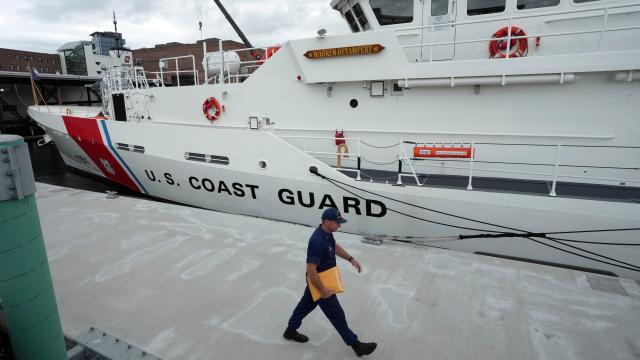A “debris field” was found in the area where authorities were searching for the missing Titanic submersible four days after the vessel disappeared, the U.S. Coast Guard announced Thursday. In a race against the clock, the search and rescue mission, which started Sunday, has come to a close, Rear Admiral John Mauger said in a press conference on Thursday afternoon. All five passengers are presumed dead.
Mauger said the debris found was consistent with a “catastrophic implosion” of the vessel, and when asked if the Titan had crashed into the Titanic wreckage, expert Paul Hankins, a director of the Salvage Operations and Ocean Engineering for the U.S. Navy, said the Titan had been found 1,600 feet from the bow of the Titanic and that there wasn’t any wreckage near the ship itself. He said at this time, all indicators point to a “catastrophic loss of pressure” and an implosion in the water column of the Titan.
Hankins said, “We found five different major pieces of debris that told us that it was the remains of Titan” across one large debris site and one smaller site. At the larger of the two sites was the nose cone, outside pressure hold, and the front and bell of the pressure hull. At the smaller debris site, Hankins said they found the other end of the pressure hull. He added: “That was the first indication there had been a catastrophic event.”
Mauger said during the conference that they are still working to identify the timeline of the wreckage and that the families of the five crew members on board have been notified. When asked about recovering the remains of the crew members, Mauger said he didn’t have an answer at this time, only that, “This an incredibly unforgiving environment down there on the sea floor, and the debris is consistent with a catastrophic implosion of the vessel.”
The submersible was carrying five passengers when it disappeared only one hour and 45 minutes into its voyage. Titan’s operator, OceanGate Expeditions, reported it has “somehow lost communications with the vessel,” U.S. Coast Guard Rear Admiral John Mauger’s remarks at a press conference Monday.
Search planes, ships, and underwater robots were deployed to conduct an aerial and surface search, across 700 square miles of terrain. Sonar buoys were added to the search efforts on Tuesday and picked up what appeared to be banging sounds coming from beneath the water. The banging sounds were detected every 30 minutes, according to a U.S. government memo, which reported that four hours later, the sounds could still be heard. CNN and Rolling Stone first reported the potential development
The memo was later updated, saying: “Additional acoustic feedback was heard and will assist in vectoring surface assets and also indicating continued hope of survivors.”
Yet hope to find the Titan was dwindling Thursday as the oxygen supply was projected to have run out just before 7:10 a.m. on Thursday, and Coast Guard Capt. Jamie Frederick said on Wednesday that the remaining oxygen was “a dialogue that’s happening,” but added it was not the only factor in the search.
Guillermo Sohnlein, the co-founder of OceanGate, said in a post on Facebook that Thursday would be “a critical day” in the search. He said he believed the crew realized they needed to relax “as much as possible,” which would extend the limits of the oxygen. “I firmly believe that the time window available for their rescue is longer than what most people think,” Sohnlein said.
As the search to explore the debris found on the ocean floor continues, reports have surfaced that OceanGate was warned about safety issues on board the Titan years before the ship disappeared. In 2018, David Lochridge, an employee at OceanGate, raised safety concerns with OceanGate management and government regulators, claiming the Titan’s design and protocol to test the hull’s reliability raised red flags.
Lochridge claimed in a wrongful termination lawsuit, saying he objected to OceanGate’s decision to test the hull’s capabilities without “non-destructive testing to prove its integrity.” The legal filing continued: “The paying passengers would not be aware, and would not be informed, of this experimental design, the lack of non-destructive testing of the hull, or that hazardous flammable materials were being used within the submersible.”
